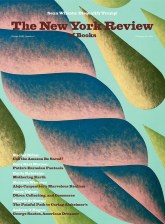In response to:
Camus on Tour from the November 23, 2023 issue
To the Editors:
In her flavorful review of Albert Camus’s Travels in the Americas [“Camus on Tour,” NYR, November 23, 2023], Vivian Gornick touches a bit cavalierly on the writer’s wartime life. Gornick writes that “when the war started [Camus] joined the Resistance and soon became the editor of Combat.” But the Resistance publication Combat only appeared in 1944, which is hardly “soon” after the Nazi occupation of France in 1940. Moreover, except for this late (and wonderful) Resistance journalism, Camus’s involvement with La Résistance remains somewhat murky. He himself was reluctant to talk about it, even with his friend former Resistance fighter Germaine Brée, who wrote one of the first books on Camus and consulted him about it.
On the other hand, what is known is that far from joining the Resistance when the war started, Camus lived for a year in 1942–1943 in the area of the village of Le Chambon-sur-Lignon in the mountains of south-central France. That area is known to have been a singularly committed place of refuge for Jews in Nazi-occupied Europe (and happens to be where my parents found refuge and where I was born). At that time, Camus was mainly concerned with his health and with making headway on his new novel about people fighting a plague.
While there are inescapable echoes of wartime Le Chambon in The Plague, as I mentioned in my 1989 documentary Weapons of the Spirit (soon to be rereleased in a newly remastered edition), for some reason Camus never referred publicly to the peasants and villagers of the area—mostly descendants of the Huguenots, the first Protestants in Catholic France—who were so remarkably committed to the nonviolent struggle against the most vicious form of the Nazi plague.
And wasn’t Camus famously conflicted about the colonial regime in his homeland of French Algeria, rather than “bitterly opposed” to it?
Pierre Sauvage
President Chambon Foundation
Los Angeles



